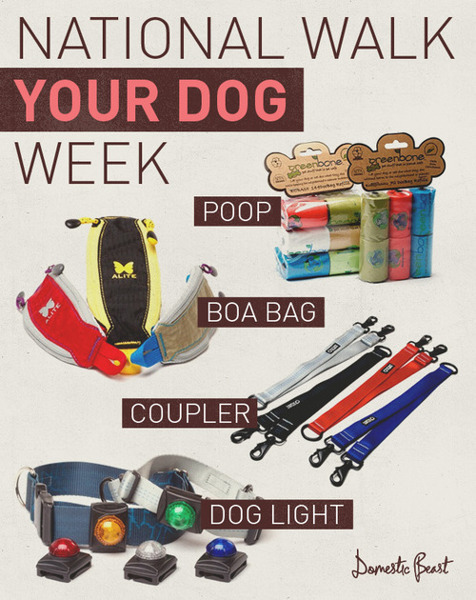National Walk Your Dog Week on October, 2024: question about taking my dog for walks.?
National Walk Your Dog Week 2024. National Walk Your Dog Week National Walk Your Dog Week
As an Amazon Associate I earn from qualifying purchases.

NEVER ever walk your dog off-leash - especially in the woods if you are not 100% certain she will listen to you.
You should never ever walk your dogs off leash in the park or neighborhoods either.
I am so happy to hear that is NOT an option for you (this is directed to the person that wanted you to walk your dog off-leash).
The thing is - you can't let her sniff. Cesar Millan (genius by the way) states that if you control the dogs head, you are 80% of the way done.
Begin your walk. Keep it brisk and under no circumstance allow her to stop. According to Cesar, pack leaders don't say anything, but anytime my dogs stop, I say let's go in a happy voice and away we go. The thing is - do not stop - not even if she does. If you keep walking, she has to - no matter what kind of collar you have on her!
After about 15 minutes, stop and allow her to do her business. Give her a few minutes to sniff around, pee, poop, whatever.
Then finish your walk. And the entire time keep her head up. Anytime she lowers it, you can give a quick pull and say, "head up" so that she will begin to understand a new command and what you want. Don't say no (they hear that all the time anyway :), and they won't know what you are saying no to, smelling, seeing, walking, sniffing).
The gentle leader works for some dogs, but my dog spent the entire walk with his head plastered (sideways no less!) to the sidewalk trying to "wipe" the leader off his face. After two weeks of head up etc I gave up on it. I use a pinch collar, which honestly I think are much more humane (oddly enough) than a choke collar. My dog will NOT choke itself to get to wherever because of the pinch. I do not have to "pop" the leash as is reccommended for choke collars because of the prongs.
The prongs are NOT sharp, and they mimic the "bite" a dog would receive in the wild if it is doing something it isn't supposed to. They do not pierce the skin, nor do they choke the dog.
PetCo sells some leashes that we love. They are 4 ft long but they have a "traffic" handle on them about a foot up. You can walk the dog using the traffic handle the whole walk (I do this with 3 dogs every day). This keeps them next to you and their heads up because they don't have a bajillion feet of leash to do whatever they want. They are therefore forced to walk as a pack next to their pack leader and to keep their heads up.
Right now, your dog is getting no mental challenge from the walk - she is frolicking. In nature, when the pack moves, it means business and they are not sniffing and frolicking. They are migrating.
If you have the National Geographic channel - watch Cesar!! (the Dog Whisperer) or buy his videos - they are worth 10 times their weight in gold! I promise!

Would a dog be helpful?
Would a dog help you for emotional support? Probably. Numerous studies have shown positive mental benefits from pet ownership.
However, generally a Sib would not be a good choice for a service dog for two reasons: first, they shed like crazy. Service dogs work in public places and must be immaculately groomed. Even with your best grooming efforts, a Sib is going to be leaving behind considerable hair which is not fair to merchants and down-right a health hazard in restaurants.
Second, Sibs are known to be difficult to train. I'm not saying it can't be done, but is it practical to choose a dog who isn't suited for the work and try to stuff him into the role? The old square peg in a round hole thing. I know a very expert trainer (utility level obedience competitor) who trains a Sib. Though her dog is wonderful, he is not nearly as reliable as my dog.
In addition to the breed issues, you have two others to overcome to get a service dog. First, you must qualify legally is a disabled.
"It is not enough to have a mental illness to qualify as a person with a disability under the ADA. According to the NIMH, 26.2% of adults in the U.S. suffer from a mental illness in any given year, but only 6% are severely mentally ill. So more than three quarters of those with a diagnosed mental illness are not disabled by that illness and would not qualify to use a service animal even if they would benefit from one."
-- Service Dog Central
The legal definition is that the person be substantially limited in one or more major life activities (breathing, seeing, walking, etc.). So you need to have a discussion with your psychiatrist about whether or not you are severely mentally ill and disabled.
The next problem is training. It typically takes 18-24 months to fully train a service dog. It's not the sort of project a pet trainer can do on their own because it takes advanced skill. That means hiring a professional to either train the dog for you or to help you train the dog yourself. At $50 per hour (on average) that's expensive. It is considerably more cost-effective to get a dog trained by a volunteer program that specializes in service dogs and runs on donations to defray most of the costs of training.
Service dogs are trained in three areas: obedience, tasks, and public access. Here's a book you can download on line from the National Service Dog Center that explains the core obedience skills all service dogs need to master:
That's 6-12 months of training right there.
Then there's task training. You see a service dog is legally defined as a dog individually trained to perform tasks that mitigate the disability of their owner. Without tasks, it isn't a service dog.
‘‘Animals whose sole function is to provide emotional support, comfort, therapy, companionship, therapeutic benefits, or promote emotional wellbeing are not service animals.’’
-- U.S. Department of Justice
Task training typically takes about six months.
Lastly there's public access training. The bulk of this training is distraction work or teaching the dog to work reliably in all situations. It's the most boring part of training because it means lots and lots of repetition. This part typically takes about six months.
For more information on whether you qualify and what is needed for a service dog, consult the U.S. Department of Justice's toll-free ADA hotline at: 800 - 514 - 0301

Some tips to help me with my dog?
Ivy is correct. Cesar Millan..Dog Whisperer has a great tv show, many books and dvd's with easy to follow info on correcting the unwanted behavior.
These kind of problems are very common and begin to develop in dogs that have taken over the leadership in their pack..."your family and all humans and anumals who live with you".
If the owner/s do not establish leadership with their dog, the dog will take the leader position.
Dogs are very basic in their thinking... one leader per pack and all others are followers.
The leader makes the rules and does what he chooses. The followers in the pack follow the leaders rules.
So now you have to reestablish leadership with your dog. It is actually very simple and watching the tv show or a dvd will be of great help to you.
You will start with walking your dog and doing it correctly with you in front and the dog next to or slightly behind you. The leader is always in front.
You will use a collar and short leash. You should walk the dog at least once a day.
To keep the dog walking correctly next to you, when he tries to pull away or get in front, you give a quick tug on the leash then immediately release the tension on the leash.
If your dog pulls and you just pull back, the dog will always pull in the opposite direction and you will get nowhere with the training.
So, walk with the leash relaxed, you relax and be calm and confident. If/when the dog tries to do anything but calmly walk next to you, give that quick tug then release on the leash.
You may have to do this on many walks till the dog and you get the idea or it may work almost immediately.
Other areas where you must be the leader...do not let the dog on furniture, beds, etc without first being invited. If the dog goes wherever he wants whenever he wants, he is displaying his dominance and leadership over you. Yelling, hitting, time out, etc do not work to change this behavior. Only you, regaining leadership thru your daily interaction with the dog will change the situation.
See Cesar on National Geographic Channel. Next episode Jan. 28
Check out the web site for some ideas and then watch the show...
Check out some videos...
's%2BWay&utm_medium=Main%2BNAV&utm_campaign=Cesar's%2BWay%20Main%20NAV



















